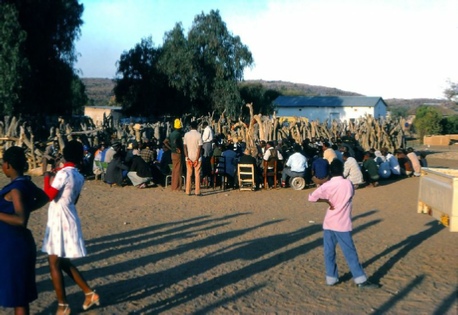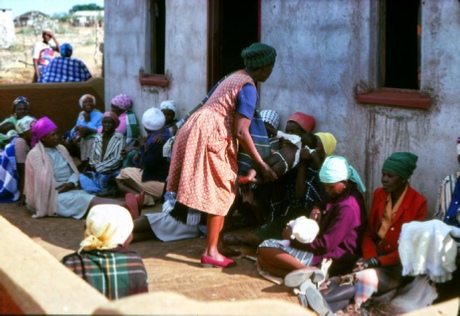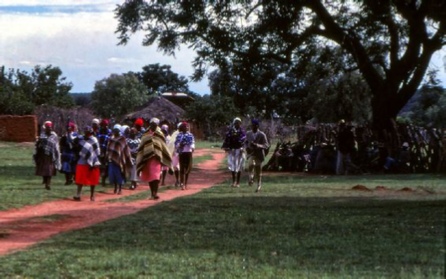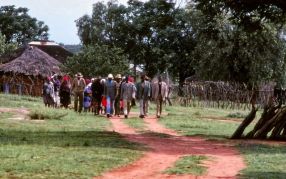© 2018 Dr Margaret Sheppard
Marriage - Bogadi (bridewealth) and Weddings
It should be noted that although a man marries a woman (monna o nyala mosadi), a woman is married by a man (i.e. mosadi o nyalwa monna).
The preferred time of the year for marriages is after harvesting and before people go to the Lands for the new ploughing season, i.e. the time of the year when most people will be staying at their homes in the village. Families prefer to hold marriages in a year when there has been a successful sorghum harvest, so that there is plenty of sorghum for making porridge to feed people who help in the preparations, and for making traditional beer that will be drunk during the marriage.
The two families will meet, usually at the bride's home, and agree when the wedding will be and what type of wedding it will be. Whichever type they decide on (either Setswana or the so-
When the women come to work on these tasks they are always fed, in rich families a beast may even be slaughtered to feed them. The concrete and brick houses are thoroughly cleaned and the cement floors highly polished, particular attention being paid to the house at the groom's paternal yard where the couple will live. Normally the fiance not only tries to build a new house for his wife to live in, but he will try to equip it with furniture.
The male relatives will gather at the respective homes to collect loads of firewood for all the cooking that will be done, to repair the kraals in the family dikgotla (these are used for containing the Bogadi (bridewealth) cattle and also for slaughtering the beasts for the feasts), and the stick fencing used to shelter the cooking areas and for the outer fences of the yards will be repaired. If it is to be a Sekgoa wedding (the so-
Registration
About three weeks before the wedding , relatives gather at the respective homes and meet together at the places of registration. All marriages are first registered at the at the Chief's Kgotla and then may also, if it is to be a Sekgoa wedding, be registered at the District Administration Office in Kanye and/or at a Church. Paternal and maternal relatives from both sides of the family go to the registration, especially the older married people. The best man and other attendants of the groom accompany him, and the senior bridesmaid (and maybe some of the others) accompany the bride.
For this occasion the bride will be dressed in new clothes such as a dress and jacket or suit (crimpelene was very much in fashion at the time of my fieldwork), and a new head scarf, stockings/tights, and new shoes. She will also wear a lightweight blanket like a shawl around her shoulders. All the women will dress in similar fashion wearing their best clothes and wearing head scarves with blankets around their shoulders. The groom will wear a suit, gloves and a hat. All the men will be dressed in suits or jackets and ties and wear hats (even if they are old ones).
The marriage is registered for three weeks. During this time, anyone with any objections may object. A common objection is when the groom has had children with another woman, and he has not completely paid all the "damages" to her parents. Her parents will then object and report the matter at the Chief's Kgotla. His present marriage will then be postponed until he has finished paying the damages ordered. A wedding may also be delayed if the Bogadi of one of the couple's mothers has not yet been paid in full, or if it was not “cooked for" by her own family. These stages of the mothers' weddings are particularly important if a child's parents were married with a Setswana wedding but the child wishes to have a Sekgoa wedding. I witnessed an example of this situation in 1979. Before a certain wedding could take place, the groom's mother and all her children had "to wear the lomipi" (the peritoneum) of a sheep that was specially slaughtered for this purpose. When this groom's parents had originally married (probably about 40 years before), his mother's family had never '”cooked” for the Bogadi, i.e. slaughtered a beast specially and given a feast for it, then tied the peritoneum around the necks of the bride and groom. The groom's elder brother and sister were already married but had married with Setswana weddings, but as he wanted to have a Sekgoa marriage the traditional Tswana customs had to be completed first from his parents' wedding.
For this ceremony wearing the lomipi (peritoneum)-
Apparently in the old days when this was done it was part of the wedding, and the actual wearing of the lomipi was done in public. The couple would wear it throughout the wedding and choirs would sing traditional songs (this is perhaps where the idea of choirs at Sekgoa weddings originally comes from.)
Nowadays “wearing the lomipi" is becoming unpopular with modern brides, and "wearing the wedding veil" in a Sekgoa marriage is seen as a substitute. A woman originally from the home of one of my neighbours did this rather than "wear the lomipi" in October 1980, so that her son would be able to have a Sekgoa wedding. This lady and her husband had originally been married around 1942 with a Setswana wedding, and had failed to "wear the lomipi".Their son who was born in 1945 and married, also with a Setswana wedding, about 1970, as he was a Christian, he now wanted to be married in a church and so this would be a Sekgoa Wedding. As the parents were also Christians they chose "to wear the wedding veil" and so they had a Sekgoa wedding complete with white wedding dress and and "change clothes". They have four grown up children and several grandchildren! (Further details of this wedding are in the section “Other Weddings”.
These two examples perhaps illustrate the importance still attached to traditional customs.
After the registration of the marriage at the Chief's Kgotla both families will return to their respective homes. The men lead and the women follow with the bride. When they arrive at the bride's home, there is much ululating and the women may be singing traditional songs such as "Coco (knock) we are arriving with a bride." The men return to sit in the family Kgotla whereas the women return into the yard and sit in the lolwapa of the house to be used for the marriage, this should be the home of the bride's mother. At the groom's home, his mother's own house is used as the focal point of the wedding in the lolwapa, as a child is supposed to be married from its mother's own house.
If it is a Tswana wedding the wedding feast may then follow (see section on Tswana Weddings)




The beasts that will be used for Bogadi will have been collected in the kraal in the village overnight, they are brought out. The groom will be dressed in a new suit and all the other men will be wearing suits or jackets. The women will be dressed in clothes suitable for going to the Kgotla of the Chief -
About 7.00 -
The bride has to remove her head scarf to prove that she is not pretending to be younger than she really is. They are both asked if they have any other children with other partners. If the answers are satisfactory, the Chief is then shown the Bogadi. The Chief may refuse to register a marriage unless the Bogadi is available. For example at one wedding I attended, the Bogadi beasts unfortunately escaped from the groom's family kraal during the night before the marriage and returned to their Cattle post. They tried to register the marriage as scheduled the next day explaining the accident that had happened to the Bogadi., but the Chief refused registration. saying that he did not want people to cheat and not pay. The marriage then had to be postponed while the groom and his family searched for the cattle.